A Detailed Comparison of CSR and CSV in Modern Business Practices
VerifiedAdded on 2023/06/15
|7
|1688
|68
Essay
AI Summary
This essay provides a comparative analysis of Corporate Social Responsibility (CSR) and Creating Shared Value (CSV), highlighting their key differences and impacts on business and society. CSR is portrayed as a business approach focused on contributing to sustainable development through economic, social, and environmental benefits for stakeholders, often driven by ethical standards and compliance. CSV, on the other hand, is presented as a business concept where organizations identify growth opportunities by addressing social problems as business objectives, emphasizing the interconnectedness of societal and economic progress. The essay outlines the three primary ways companies can create shared value: reconceiving products and markets, redefining productivity in the value chain, and enabling local cluster development. It further contrasts CSR, which is often seen as a cost center focused on enhancing corporate reputation, with CSV, which aims to drive profitability and competitive advantage through minimizing social problems and leveraging organizational expertise. Examples like Vinamilk, Coca Cola, IBM, Intel, Walmart and Nestle are used to illustrate these concepts, ultimately arguing that CSV seeks to create both economic and social value, whereas CSR primarily focuses on furthering social good through corporate actions. Desklib provides students access to similar solved assignments and study resources.
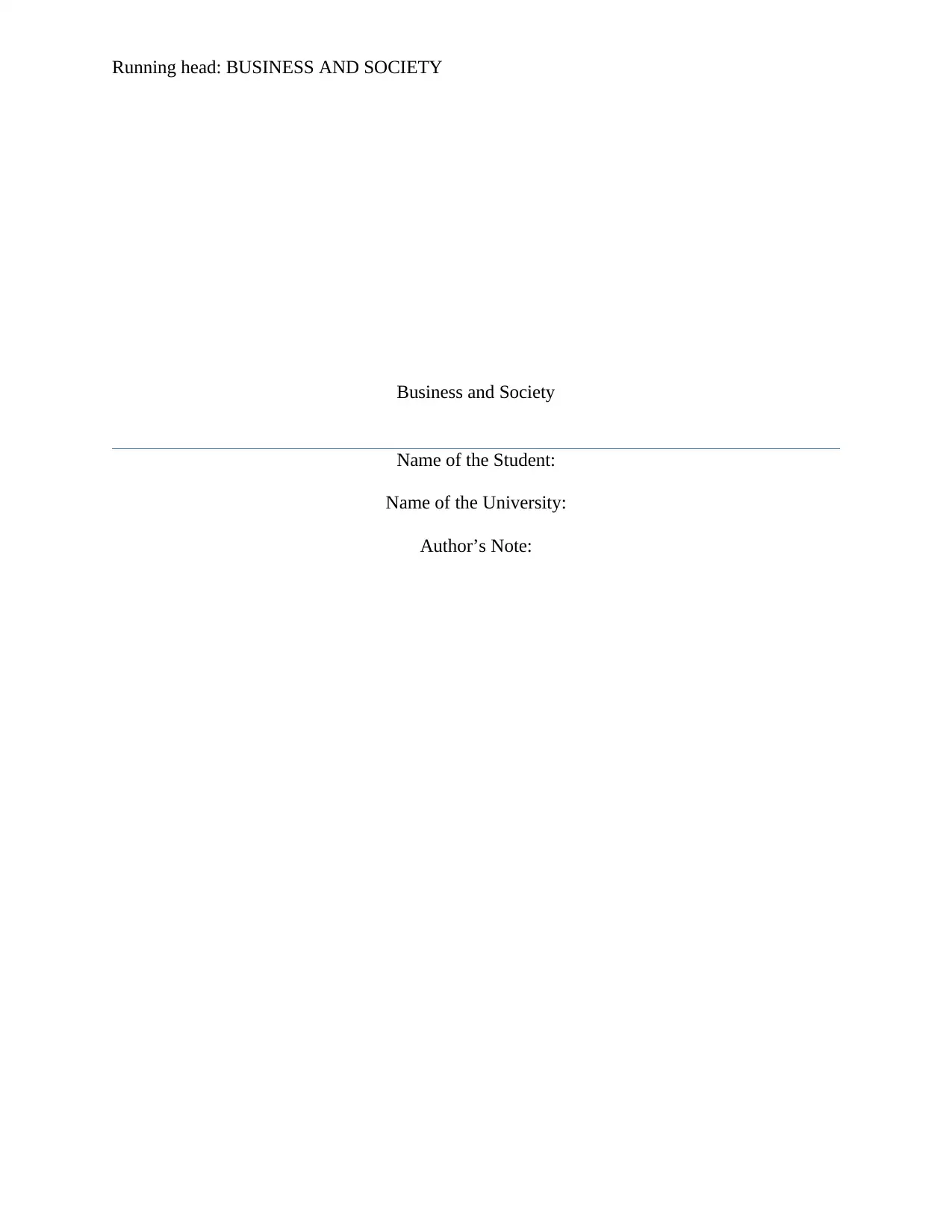
Running head: BUSINESS AND SOCIETY
Business and Society
Name of the Student:
Name of the University:
Author’s Note:
Business and Society
Name of the Student:
Name of the University:
Author’s Note:
Paraphrase This Document
Need a fresh take? Get an instant paraphrase of this document with our AI Paraphraser
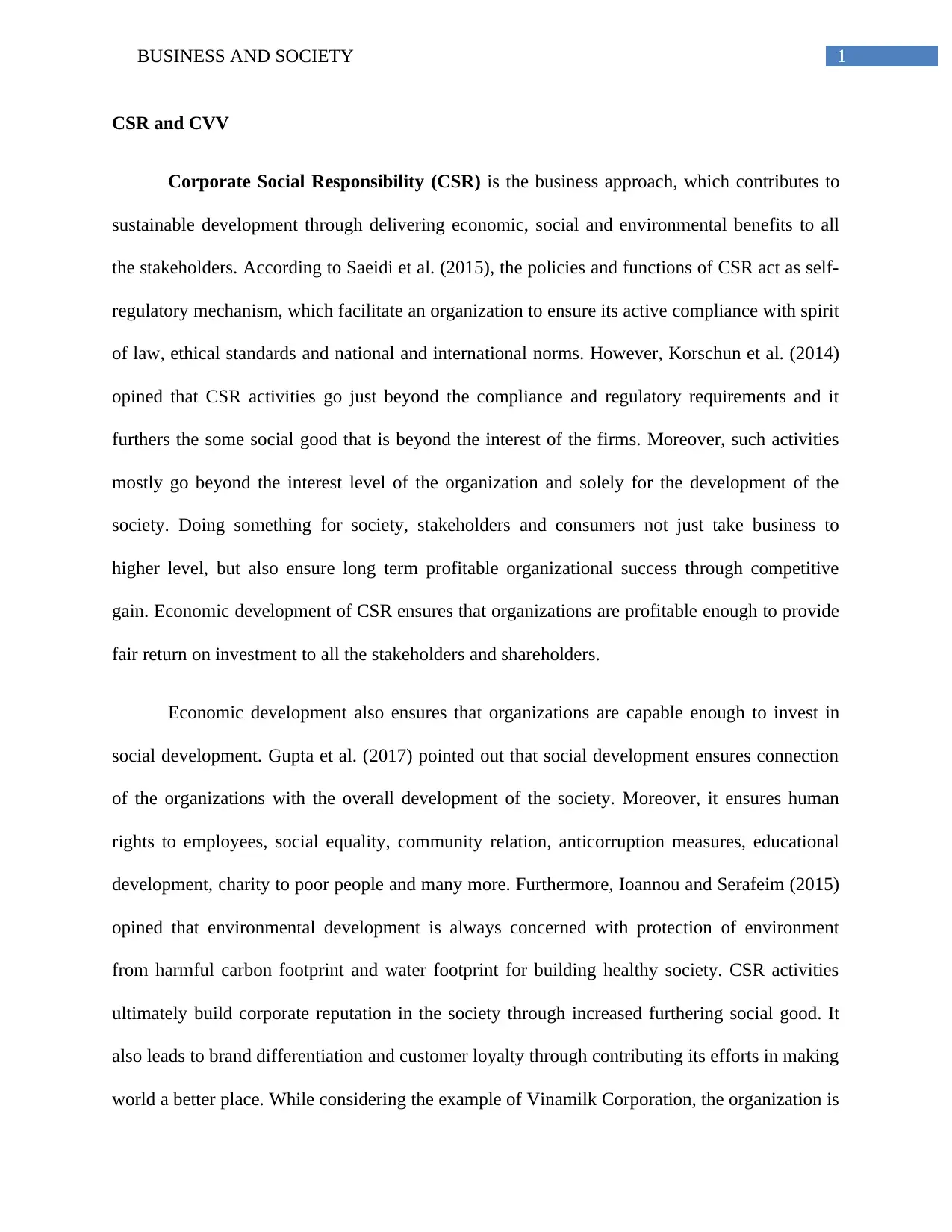
1BUSINESS AND SOCIETY
CSR and CVV
Corporate Social Responsibility (CSR) is the business approach, which contributes to
sustainable development through delivering economic, social and environmental benefits to all
the stakeholders. According to Saeidi et al. (2015), the policies and functions of CSR act as self-
regulatory mechanism, which facilitate an organization to ensure its active compliance with spirit
of law, ethical standards and national and international norms. However, Korschun et al. (2014)
opined that CSR activities go just beyond the compliance and regulatory requirements and it
furthers the some social good that is beyond the interest of the firms. Moreover, such activities
mostly go beyond the interest level of the organization and solely for the development of the
society. Doing something for society, stakeholders and consumers not just take business to
higher level, but also ensure long term profitable organizational success through competitive
gain. Economic development of CSR ensures that organizations are profitable enough to provide
fair return on investment to all the stakeholders and shareholders.
Economic development also ensures that organizations are capable enough to invest in
social development. Gupta et al. (2017) pointed out that social development ensures connection
of the organizations with the overall development of the society. Moreover, it ensures human
rights to employees, social equality, community relation, anticorruption measures, educational
development, charity to poor people and many more. Furthermore, Ioannou and Serafeim (2015)
opined that environmental development is always concerned with protection of environment
from harmful carbon footprint and water footprint for building healthy society. CSR activities
ultimately build corporate reputation in the society through increased furthering social good. It
also leads to brand differentiation and customer loyalty through contributing its efforts in making
world a better place. While considering the example of Vinamilk Corporation, the organization is
CSR and CVV
Corporate Social Responsibility (CSR) is the business approach, which contributes to
sustainable development through delivering economic, social and environmental benefits to all
the stakeholders. According to Saeidi et al. (2015), the policies and functions of CSR act as self-
regulatory mechanism, which facilitate an organization to ensure its active compliance with spirit
of law, ethical standards and national and international norms. However, Korschun et al. (2014)
opined that CSR activities go just beyond the compliance and regulatory requirements and it
furthers the some social good that is beyond the interest of the firms. Moreover, such activities
mostly go beyond the interest level of the organization and solely for the development of the
society. Doing something for society, stakeholders and consumers not just take business to
higher level, but also ensure long term profitable organizational success through competitive
gain. Economic development of CSR ensures that organizations are profitable enough to provide
fair return on investment to all the stakeholders and shareholders.
Economic development also ensures that organizations are capable enough to invest in
social development. Gupta et al. (2017) pointed out that social development ensures connection
of the organizations with the overall development of the society. Moreover, it ensures human
rights to employees, social equality, community relation, anticorruption measures, educational
development, charity to poor people and many more. Furthermore, Ioannou and Serafeim (2015)
opined that environmental development is always concerned with protection of environment
from harmful carbon footprint and water footprint for building healthy society. CSR activities
ultimately build corporate reputation in the society through increased furthering social good. It
also leads to brand differentiation and customer loyalty through contributing its efforts in making
world a better place. While considering the example of Vinamilk Corporation, the organization is
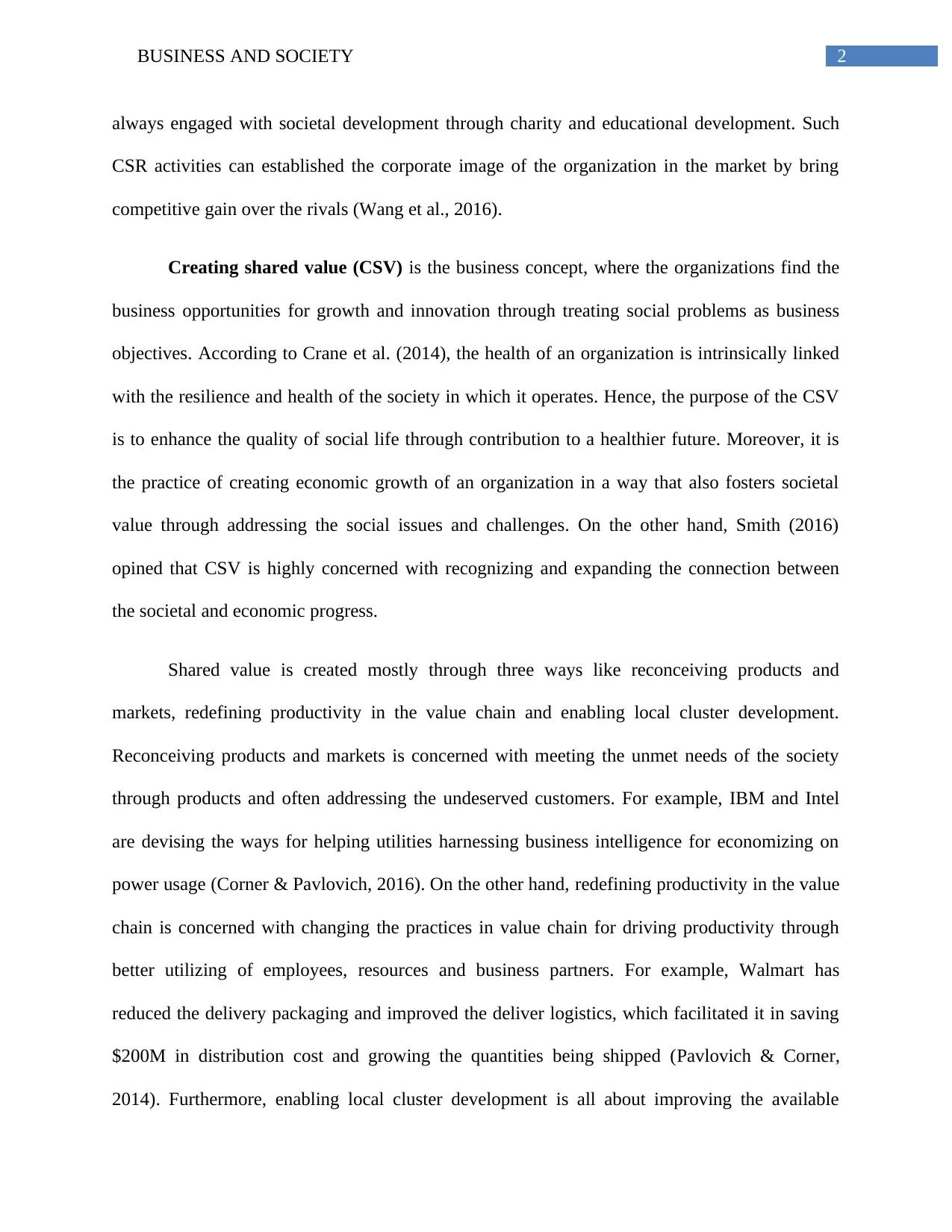
2BUSINESS AND SOCIETY
always engaged with societal development through charity and educational development. Such
CSR activities can established the corporate image of the organization in the market by bring
competitive gain over the rivals (Wang et al., 2016).
Creating shared value (CSV) is the business concept, where the organizations find the
business opportunities for growth and innovation through treating social problems as business
objectives. According to Crane et al. (2014), the health of an organization is intrinsically linked
with the resilience and health of the society in which it operates. Hence, the purpose of the CSV
is to enhance the quality of social life through contribution to a healthier future. Moreover, it is
the practice of creating economic growth of an organization in a way that also fosters societal
value through addressing the social issues and challenges. On the other hand, Smith (2016)
opined that CSV is highly concerned with recognizing and expanding the connection between
the societal and economic progress.
Shared value is created mostly through three ways like reconceiving products and
markets, redefining productivity in the value chain and enabling local cluster development.
Reconceiving products and markets is concerned with meeting the unmet needs of the society
through products and often addressing the undeserved customers. For example, IBM and Intel
are devising the ways for helping utilities harnessing business intelligence for economizing on
power usage (Corner & Pavlovich, 2016). On the other hand, redefining productivity in the value
chain is concerned with changing the practices in value chain for driving productivity through
better utilizing of employees, resources and business partners. For example, Walmart has
reduced the delivery packaging and improved the deliver logistics, which facilitated it in saving
$200M in distribution cost and growing the quantities being shipped (Pavlovich & Corner,
2014). Furthermore, enabling local cluster development is all about improving the available
always engaged with societal development through charity and educational development. Such
CSR activities can established the corporate image of the organization in the market by bring
competitive gain over the rivals (Wang et al., 2016).
Creating shared value (CSV) is the business concept, where the organizations find the
business opportunities for growth and innovation through treating social problems as business
objectives. According to Crane et al. (2014), the health of an organization is intrinsically linked
with the resilience and health of the society in which it operates. Hence, the purpose of the CSV
is to enhance the quality of social life through contribution to a healthier future. Moreover, it is
the practice of creating economic growth of an organization in a way that also fosters societal
value through addressing the social issues and challenges. On the other hand, Smith (2016)
opined that CSV is highly concerned with recognizing and expanding the connection between
the societal and economic progress.
Shared value is created mostly through three ways like reconceiving products and
markets, redefining productivity in the value chain and enabling local cluster development.
Reconceiving products and markets is concerned with meeting the unmet needs of the society
through products and often addressing the undeserved customers. For example, IBM and Intel
are devising the ways for helping utilities harnessing business intelligence for economizing on
power usage (Corner & Pavlovich, 2016). On the other hand, redefining productivity in the value
chain is concerned with changing the practices in value chain for driving productivity through
better utilizing of employees, resources and business partners. For example, Walmart has
reduced the delivery packaging and improved the deliver logistics, which facilitated it in saving
$200M in distribution cost and growing the quantities being shipped (Pavlovich & Corner,
2014). Furthermore, enabling local cluster development is all about improving the available
⊘ This is a preview!⊘
Do you want full access?
Subscribe today to unlock all pages.

Trusted by 1+ million students worldwide
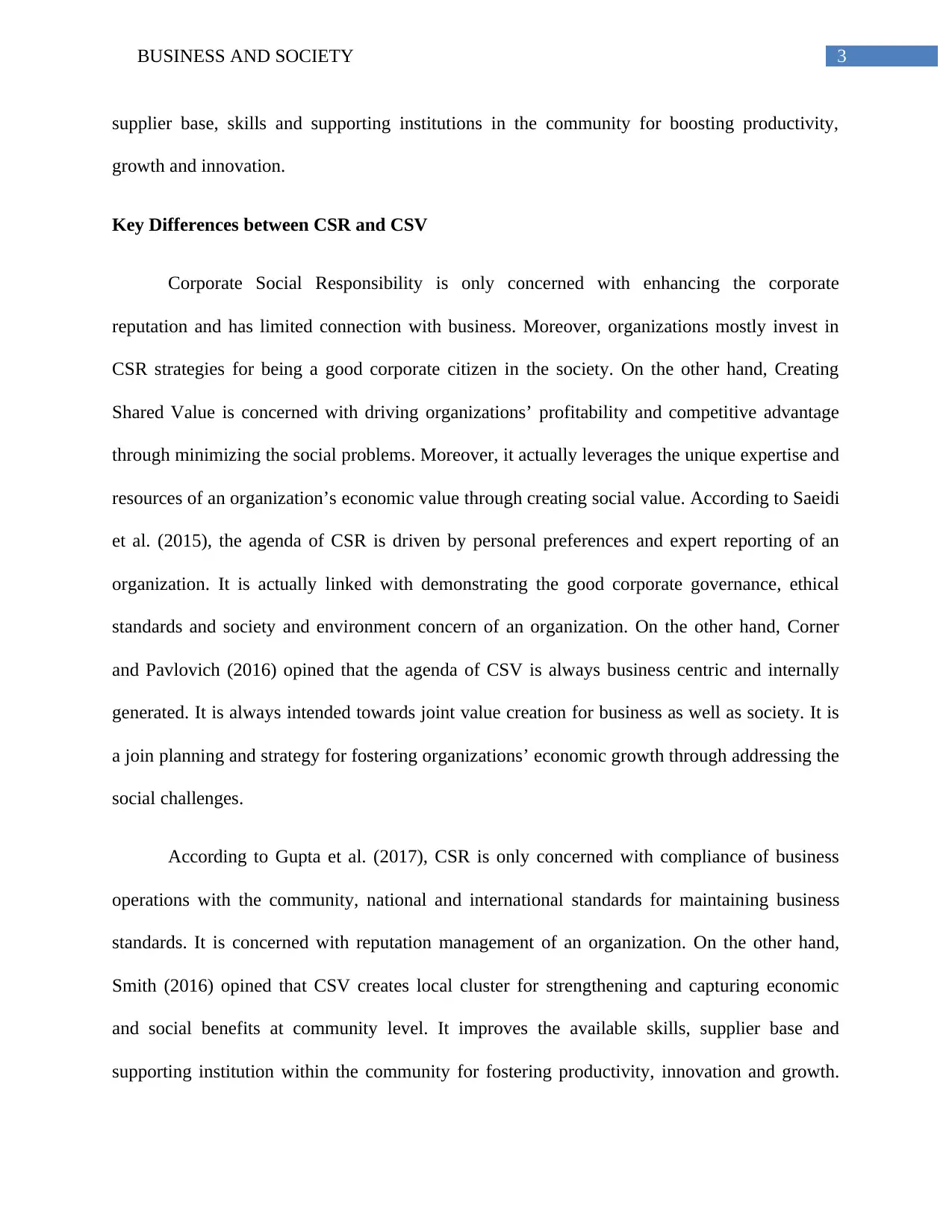
3BUSINESS AND SOCIETY
supplier base, skills and supporting institutions in the community for boosting productivity,
growth and innovation.
Key Differences between CSR and CSV
Corporate Social Responsibility is only concerned with enhancing the corporate
reputation and has limited connection with business. Moreover, organizations mostly invest in
CSR strategies for being a good corporate citizen in the society. On the other hand, Creating
Shared Value is concerned with driving organizations’ profitability and competitive advantage
through minimizing the social problems. Moreover, it actually leverages the unique expertise and
resources of an organization’s economic value through creating social value. According to Saeidi
et al. (2015), the agenda of CSR is driven by personal preferences and expert reporting of an
organization. It is actually linked with demonstrating the good corporate governance, ethical
standards and society and environment concern of an organization. On the other hand, Corner
and Pavlovich (2016) opined that the agenda of CSV is always business centric and internally
generated. It is always intended towards joint value creation for business as well as society. It is
a join planning and strategy for fostering organizations’ economic growth through addressing the
social challenges.
According to Gupta et al. (2017), CSR is only concerned with compliance of business
operations with the community, national and international standards for maintaining business
standards. It is concerned with reputation management of an organization. On the other hand,
Smith (2016) opined that CSV creates local cluster for strengthening and capturing economic
and social benefits at community level. It improves the available skills, supplier base and
supporting institution within the community for fostering productivity, innovation and growth.
supplier base, skills and supporting institutions in the community for boosting productivity,
growth and innovation.
Key Differences between CSR and CSV
Corporate Social Responsibility is only concerned with enhancing the corporate
reputation and has limited connection with business. Moreover, organizations mostly invest in
CSR strategies for being a good corporate citizen in the society. On the other hand, Creating
Shared Value is concerned with driving organizations’ profitability and competitive advantage
through minimizing the social problems. Moreover, it actually leverages the unique expertise and
resources of an organization’s economic value through creating social value. According to Saeidi
et al. (2015), the agenda of CSR is driven by personal preferences and expert reporting of an
organization. It is actually linked with demonstrating the good corporate governance, ethical
standards and society and environment concern of an organization. On the other hand, Corner
and Pavlovich (2016) opined that the agenda of CSV is always business centric and internally
generated. It is always intended towards joint value creation for business as well as society. It is
a join planning and strategy for fostering organizations’ economic growth through addressing the
social challenges.
According to Gupta et al. (2017), CSR is only concerned with compliance of business
operations with the community, national and international standards for maintaining business
standards. It is concerned with reputation management of an organization. On the other hand,
Smith (2016) opined that CSV creates local cluster for strengthening and capturing economic
and social benefits at community level. It improves the available skills, supplier base and
supporting institution within the community for fostering productivity, innovation and growth.
Paraphrase This Document
Need a fresh take? Get an instant paraphrase of this document with our AI Paraphraser
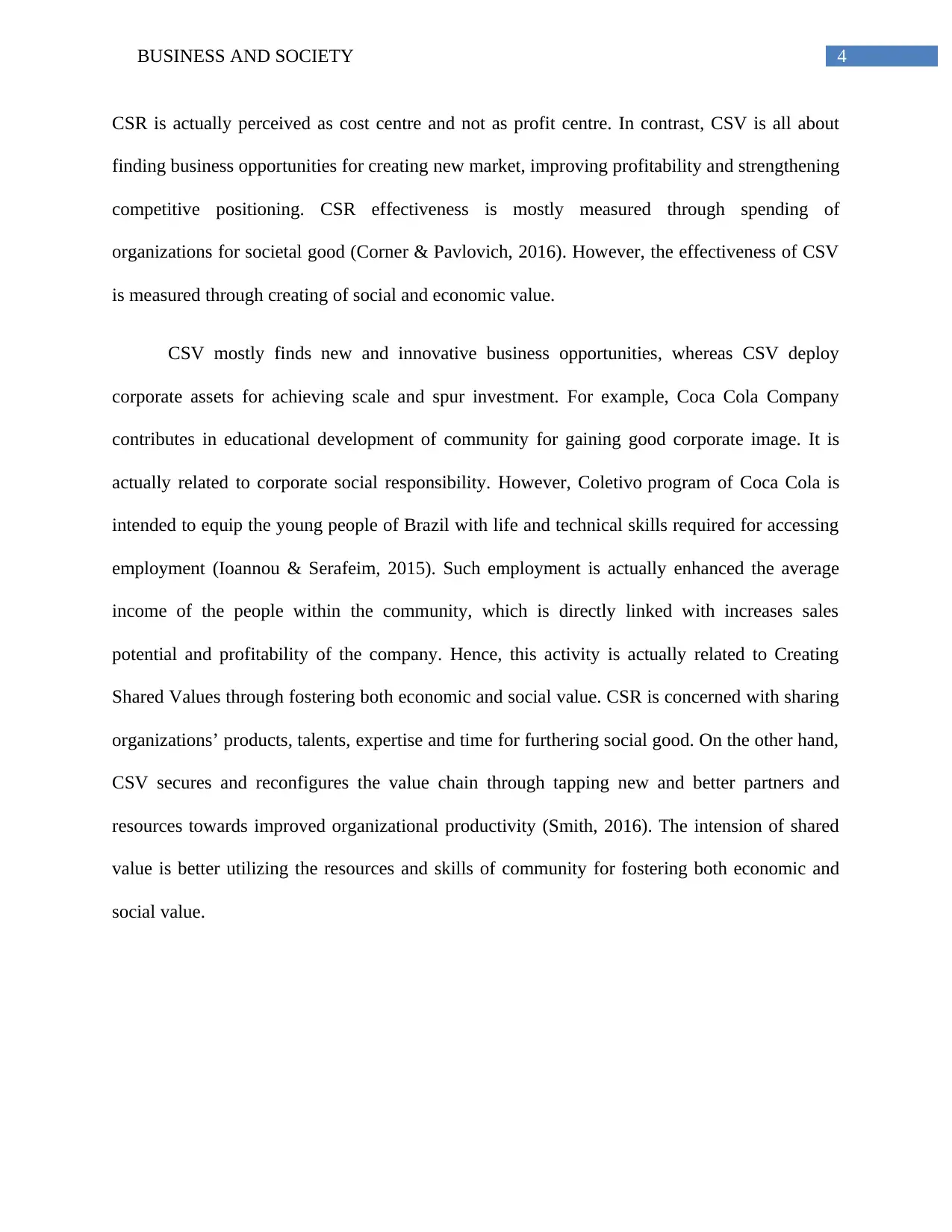
4BUSINESS AND SOCIETY
CSR is actually perceived as cost centre and not as profit centre. In contrast, CSV is all about
finding business opportunities for creating new market, improving profitability and strengthening
competitive positioning. CSR effectiveness is mostly measured through spending of
organizations for societal good (Corner & Pavlovich, 2016). However, the effectiveness of CSV
is measured through creating of social and economic value.
CSV mostly finds new and innovative business opportunities, whereas CSV deploy
corporate assets for achieving scale and spur investment. For example, Coca Cola Company
contributes in educational development of community for gaining good corporate image. It is
actually related to corporate social responsibility. However, Coletivo program of Coca Cola is
intended to equip the young people of Brazil with life and technical skills required for accessing
employment (Ioannou & Serafeim, 2015). Such employment is actually enhanced the average
income of the people within the community, which is directly linked with increases sales
potential and profitability of the company. Hence, this activity is actually related to Creating
Shared Values through fostering both economic and social value. CSR is concerned with sharing
organizations’ products, talents, expertise and time for furthering social good. On the other hand,
CSV secures and reconfigures the value chain through tapping new and better partners and
resources towards improved organizational productivity (Smith, 2016). The intension of shared
value is better utilizing the resources and skills of community for fostering both economic and
social value.
CSR is actually perceived as cost centre and not as profit centre. In contrast, CSV is all about
finding business opportunities for creating new market, improving profitability and strengthening
competitive positioning. CSR effectiveness is mostly measured through spending of
organizations for societal good (Corner & Pavlovich, 2016). However, the effectiveness of CSV
is measured through creating of social and economic value.
CSV mostly finds new and innovative business opportunities, whereas CSV deploy
corporate assets for achieving scale and spur investment. For example, Coca Cola Company
contributes in educational development of community for gaining good corporate image. It is
actually related to corporate social responsibility. However, Coletivo program of Coca Cola is
intended to equip the young people of Brazil with life and technical skills required for accessing
employment (Ioannou & Serafeim, 2015). Such employment is actually enhanced the average
income of the people within the community, which is directly linked with increases sales
potential and profitability of the company. Hence, this activity is actually related to Creating
Shared Values through fostering both economic and social value. CSR is concerned with sharing
organizations’ products, talents, expertise and time for furthering social good. On the other hand,
CSV secures and reconfigures the value chain through tapping new and better partners and
resources towards improved organizational productivity (Smith, 2016). The intension of shared
value is better utilizing the resources and skills of community for fostering both economic and
social value.
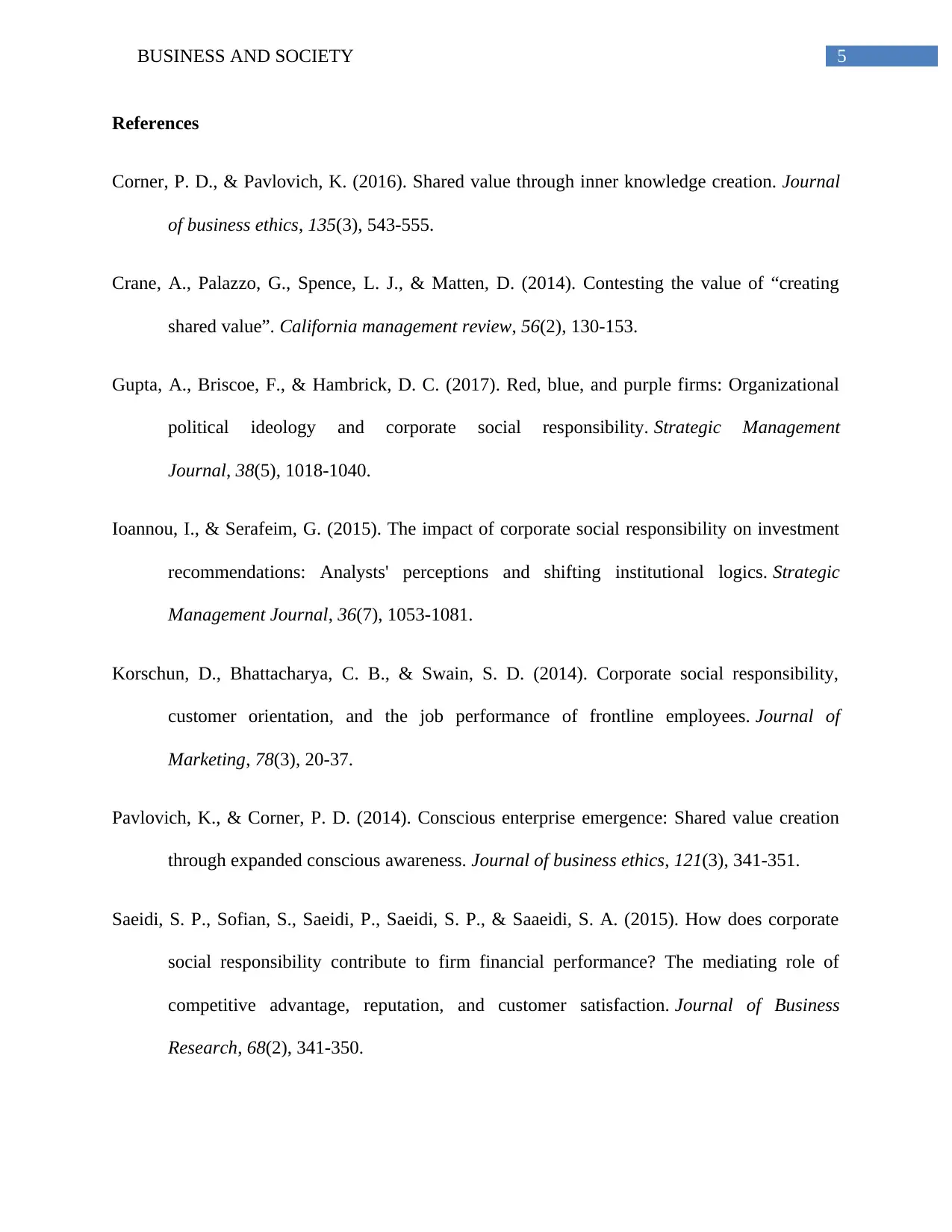
5BUSINESS AND SOCIETY
References
Corner, P. D., & Pavlovich, K. (2016). Shared value through inner knowledge creation. Journal
of business ethics, 135(3), 543-555.
Crane, A., Palazzo, G., Spence, L. J., & Matten, D. (2014). Contesting the value of “creating
shared value”. California management review, 56(2), 130-153.
Gupta, A., Briscoe, F., & Hambrick, D. C. (2017). Red, blue, and purple firms: Organizational
political ideology and corporate social responsibility. Strategic Management
Journal, 38(5), 1018-1040.
Ioannou, I., & Serafeim, G. (2015). The impact of corporate social responsibility on investment
recommendations: Analysts' perceptions and shifting institutional logics. Strategic
Management Journal, 36(7), 1053-1081.
Korschun, D., Bhattacharya, C. B., & Swain, S. D. (2014). Corporate social responsibility,
customer orientation, and the job performance of frontline employees. Journal of
Marketing, 78(3), 20-37.
Pavlovich, K., & Corner, P. D. (2014). Conscious enterprise emergence: Shared value creation
through expanded conscious awareness. Journal of business ethics, 121(3), 341-351.
Saeidi, S. P., Sofian, S., Saeidi, P., Saeidi, S. P., & Saaeidi, S. A. (2015). How does corporate
social responsibility contribute to firm financial performance? The mediating role of
competitive advantage, reputation, and customer satisfaction. Journal of Business
Research, 68(2), 341-350.
References
Corner, P. D., & Pavlovich, K. (2016). Shared value through inner knowledge creation. Journal
of business ethics, 135(3), 543-555.
Crane, A., Palazzo, G., Spence, L. J., & Matten, D. (2014). Contesting the value of “creating
shared value”. California management review, 56(2), 130-153.
Gupta, A., Briscoe, F., & Hambrick, D. C. (2017). Red, blue, and purple firms: Organizational
political ideology and corporate social responsibility. Strategic Management
Journal, 38(5), 1018-1040.
Ioannou, I., & Serafeim, G. (2015). The impact of corporate social responsibility on investment
recommendations: Analysts' perceptions and shifting institutional logics. Strategic
Management Journal, 36(7), 1053-1081.
Korschun, D., Bhattacharya, C. B., & Swain, S. D. (2014). Corporate social responsibility,
customer orientation, and the job performance of frontline employees. Journal of
Marketing, 78(3), 20-37.
Pavlovich, K., & Corner, P. D. (2014). Conscious enterprise emergence: Shared value creation
through expanded conscious awareness. Journal of business ethics, 121(3), 341-351.
Saeidi, S. P., Sofian, S., Saeidi, P., Saeidi, S. P., & Saaeidi, S. A. (2015). How does corporate
social responsibility contribute to firm financial performance? The mediating role of
competitive advantage, reputation, and customer satisfaction. Journal of Business
Research, 68(2), 341-350.
⊘ This is a preview!⊘
Do you want full access?
Subscribe today to unlock all pages.

Trusted by 1+ million students worldwide
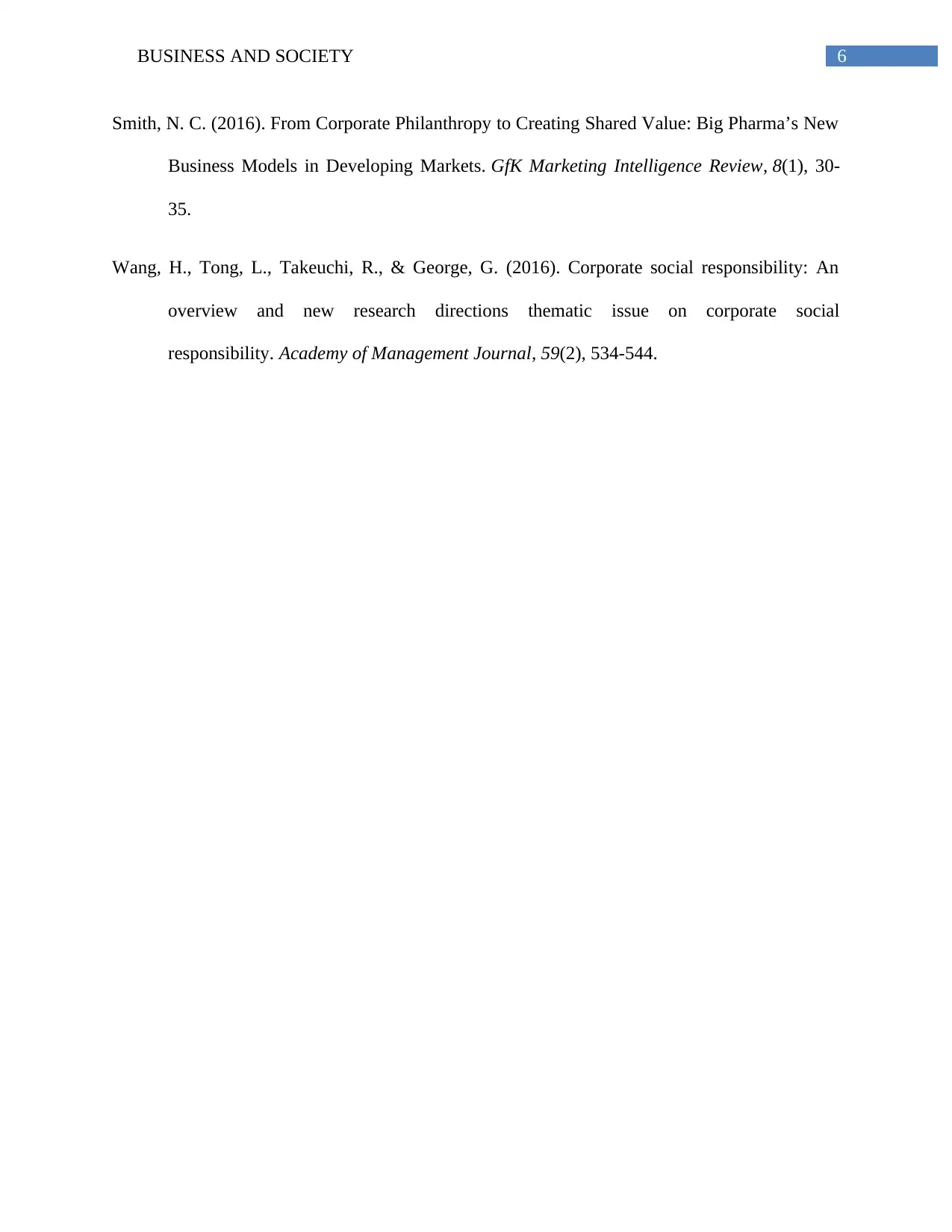
6BUSINESS AND SOCIETY
Smith, N. C. (2016). From Corporate Philanthropy to Creating Shared Value: Big Pharma’s New
Business Models in Developing Markets. GfK Marketing Intelligence Review, 8(1), 30-
35.
Wang, H., Tong, L., Takeuchi, R., & George, G. (2016). Corporate social responsibility: An
overview and new research directions thematic issue on corporate social
responsibility. Academy of Management Journal, 59(2), 534-544.
Smith, N. C. (2016). From Corporate Philanthropy to Creating Shared Value: Big Pharma’s New
Business Models in Developing Markets. GfK Marketing Intelligence Review, 8(1), 30-
35.
Wang, H., Tong, L., Takeuchi, R., & George, G. (2016). Corporate social responsibility: An
overview and new research directions thematic issue on corporate social
responsibility. Academy of Management Journal, 59(2), 534-544.
1 out of 7
Related Documents
Your All-in-One AI-Powered Toolkit for Academic Success.
+13062052269
info@desklib.com
Available 24*7 on WhatsApp / Email
![[object Object]](/_next/static/media/star-bottom.7253800d.svg)
Unlock your academic potential
Copyright © 2020–2025 A2Z Services. All Rights Reserved. Developed and managed by ZUCOL.





